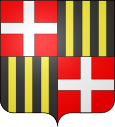Larringes
| Larringes | ||
|---|---|---|

|
|
|
| region | Auvergne-Rhône-Alpes | |
| Department | Haute-Savoie | |
| Arrondissement | Thonon-les-Bains | |
| Canton | Evian-les-Bains | |
| Community association | Pays d'Evian Vallée d'Abondance | |
| Coordinates | 46 ° 22 ′ N , 6 ° 34 ′ E | |
| height | 713-873 m | |
| surface | 8.07 km 2 | |
| Residents | 1,424 (January 1, 2017) | |
| Population density | 176 inhabitants / km 2 | |
| Post Code | 74500 | |
| INSEE code | 74146 | |
| Website | www.mairie-larringes.fr | |
Larringes is a French commune in the department of Haute-Savoie in the region of Auvergne Rhône-Alpes .
geography
Larringes is located at 792 m , seven kilometers east of the town of Thonon-les-Bains (as the crow flies). The village extends in the Chablais, in a panoramic position on the high plateau of the Pays de Gavot south of Lake Geneva and east of the Dranse valley, in the Savoy Prealps.
The area of the 8.07 km² municipal area covers a section of the high plateau in the central Chablais. The plateau slopes slightly to the west and is drained by the Maravant brook to the Dranse. The highest point of Larringes is reached at 870 m on the plateau north of Vinzier.
Larringes includes the hamlets of Chez Desbois ( 755 m ), Chez Crosson ( 800 m ), Saint-Thomas ( 780 m ) and Vérossier ( 840 m ), all on the plateau of the Pays de Gavot. Neighboring municipalities of Larringes are Publier , Évian-les-Bains and Neuvecelle in the north, Saint-Paul-en-Chablais in the east, Vinzier and Féternes in the south and Champanges in the west.
history
The municipality of Larringes was already inhabited during Roman times, which could be proven on the basis of wall foundations from that time. The place name is first mentioned in a document in 892 under the name ad Ladrini . Later the names Larringis (1170) and Larrinio (1188) appeared. The place name is probably derived from the Burgundian personal name Lader ( Ladahar ) and means “ Lader ” among the people .
In the 10th century, Larringes Castle was built on the site of the ruins of a Roman building. In the Middle Ages it belonged to the Counts of Allinges and later to the Counts of Savoy .
Attractions
The village church of Larringes and the chapel of Chez-Crosson both date from the 19th century. North-east of the village, at a beautiful vantage point, is the castle, which essentially dates back to the 10th century, but has been redesigned and restored several times over the years.
population
| Population development | |
|---|---|
| year | Residents |
| 1962 | 529 |
| 1968 | 540 |
| 1975 | 542 |
| 1982 | 583 |
| 1990 | 734 |
| 1999 | 976 |
With 1424 inhabitants (as of January 1, 2017) Larringes is one of the smaller communities in the Haute-Savoie department. In the last few decades there has been a continuous strong growth in the number of inhabitants.
Economy and Infrastructure
Larringes was a predominantly agricultural village well into the 20th century . Today there are various local small businesses. Many workers are commuters who go to work in the larger towns in the area, especially in Thonon-les-Bains.
The village is off the main thoroughfares, but is easily accessible from both Thonon-les-Bains and Évian-les-Bains . Other road connections exist with Féternes and Vinzier.
